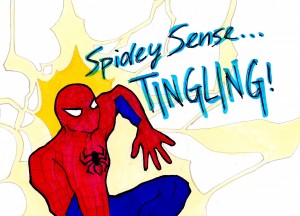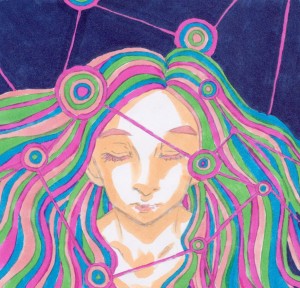
Spider-Man tingles when he senses danger…
People with ASMR tingle when they sense…pure bliss?
You know how Spider-Man had a special spider-sense that would tingle whenever danger was lurking? (Or if you don’t know anything about Spider-Man, he was this superhero who had this special superpower called a spider-sense that would tingle whenever danger was lurking.) Well, this is going to sound weird but think I have my own type of “spider-sense” because I also feel a tingling sensation at the base of my skull at specific times. However, this feeling does not arise in response to the threat of danger. In fact, it is quite the contrary—I get this tingling feeling when most at-ease.
My personal ASMR journey: It all started when…
Since I was a kid, I would get this tingling sensation in my head and question what it was: do others feel it too, or am I the only one? Did I have a superpower or sixth-sense, or did I have a mental disease? Honestly, I never found out because explaining such a sensation to another person usually just evokes confusion and head scratching.
Today however, if I had to describe my “ASMR” it would probably sound something like this:
Basically, my brain tends to generate these intensely pleasurable sensations that flow throughout my nervous system like a wave of energy, putting me into a calm, tranquil, relaxed, euphoric, feel-good, trance-like state of mind. These sensations last for only several seconds and feel like a fuzzy, tingling, prickly, tickling, caressing physical sensory eruption spontaneously traveling like a current of electricity from my head, making its way down my spine, and fading away into the other areas of my body. It kind of feels like an army ants who march from inside my head into my hair, crawl down my spine and then jump off my skin; throughout this journey they bite me, but it does not hurt. Rather, it feels as if they are injecting small bursts of relaxing pleasure into my body.

If I had to make a crude mapping of this process I would say action potentials most likely initiate and fire from the lower back regions of the brain and then conduct distally along the spinal cord and ultimately propagate into the peripheral nervous regions of the body.The physical feeling I perceive is the complete opposite of pain and can generate goose bumps (i.e. piloerection) on the skin of my neck, arms and scalp. Initiated by cognitive or psychological processing, there seems to be a blending of central and autonomic nervous system activation. The autonomic or “involuntary/automatic” part of the nervous system controls the necessary bodily functions essential to survival, such as breathing, heart rate, body temperature, blood pressure, micturition, etc. and also responds to many types of emotional stimuli. [1]
For me, one key ingredient always produces the ASMR sensation: specific behavior or mannerisms of other people while they are engaged in rather ordinary tasks, such as giving directions on how to do something, handling objects, or just speaking. These tasks are known as triggers to people in the ASMR community. Here are some examples of triggers that stimulate the ASMR response for me:
- Watching someone draw or paint (especially if they are narrating the drawing/painting process)
- Listening to the narration or reading of a story
- Watching someone gently scratch something or other movements of the hands and feet
- Having my face painted
- Being asked questions by a doctor
- Having my ears checked
- Having my breathing monitored with a stethoscope (like when the doctor says “take a deep breath”)
- Being instructed on how to do a task such as homework problems or how to do something on a computer.
To give you an example of how ASMR feels, imagine a time when you’ve had your face painted, perhaps at a carnival or art festival. You sit comfortably in a chair and remain still while the painter slowly caresses your cheek. You begin to feel a tickling, tingling sensation as the cool paint and hairs of the paint brush gently glide across your skin. This, my friends, is what ASMR feels like.

Worthy of mention is that the person who initiates the trigger exhibits a relaxed mood or speaks with a slow, mellow voice. But because I don’t really have any sentimental value attached to the event or the person involved in the trigger, it is most peculiar to why they can somehow activate my body’s pleasure circuit. Perhaps certain people just give off good “vibes.”
Back in the old days of the 1990s, my curiosity of this sensation could not be satisfied, and my dissatisfaction was intensified because no one understood it and my current go-to problem solver, the internet, wasn’t really a common option then. Today, however, the power of Google and other search engines can transport us through cyber space into virtually any destination of information, concepts or ideas. Since the few people I have talked to over the years (a few friends, a college professor, my mom…) about ASMR had never heard of the sensation and thought me a little strange, I was beginning to have a slight paranoia of having some rare neurological disease and decided to browse online for possible answers.
Luckily, the internet is full of weird people (and cats) and wacky things. This is how I found other people who experience the same mysteriously pleasant sensation as me.
Lo and behold, I can now present the name of this vague feeling. It is called “Autonomous Sensory Meridian Response,” and it is pretty awesome. You should go ahead and Google it, YouTube it, Facebook it, Reddit it, or Twitter it as you will see that I am not alone. It is wonderful to see so many forums, interest groups, blogs and other cyber-terrestrial lands scattered throughout the internet, inhabited by people who possess the exact same “spider-sense” type feeling I once believed to be my own personal superpower. There even exists an online research group who seeks to find an answer to this bizarre social phenomenon.
But….WHAT causes ASMR?
No definitive explanation for this psychophysiological phenomenon seems to exist, and though the rate of incidence is unknown as well, ASMR is probably not experienced by everyone. However, those who do notice its occurrence naturally might wonder what the tingling sensation actually is and why it happens. One could argue that most if not all sensations are encompassed by the vast, enigmatic notion of consciousness.

Many concepts involved with conscious sensory perception were once thought to be some sort of myth but are now accepted as evident processing of the mind and body. For example, synesthesia, a phenomenon many skeptics dismissed because nobody could prove it, now thrives as a hot topic in neuroscience. Synesthesia is defined as “a neurological condition in which stimulation of one sensory or cognitive pathway leads to automatic, involuntary experiences in a second sensory or cognitive pathway.”
People may report perceiving a sound as purple or perhaps smelling a particular scent and claiming it smells green. This type of sensory blending demonstrates an important feature of perception: everyone thinks and feels stimuli differently because we are all wired slightly differently in the brain and our cellular architectures all have a slightly different schematic (thanks, DNA). Further investigation of the sensory evoking entities underneath our skin will likely provide insight into why many people experience tingly waves of pleasure that surge throughout the head and peripheries, aka ASMR.
Unfortunately, ASMR has not been accepted in the scientific community. In the past, some have attempted to create a Wikipedia article for this topic but have been denied by the highly scrutinizing Wiki editors due to lack of scientific evidence. If you attempt to search “autonomous sensory meridian response” or “ASMR” in a scholarly search engine such as PubMed or Web of Science you would probably find zero exact results and would be searching for a cyber-needle in a cyber-haystack. (Trust me I’ve spent hours to days attempting to find something with no such luck.)
I have found similar topics that all seem to dance around this enigma. However, I take offense and feel discriminated against that Wikipedia would kick ASMR to the curb just because the editors have no proof. How unfair that another unexplainable sensory phenomenon called “The Hum” (The Hum, seriously?) gets to stay on Wikipedia! That’s sense-ist! I will not stand for this. I have a dream….that ASMR will become accepted on Wikipedia and scientific search databases!
Searching for the answer
Oddly enough, if you go to Wikipedia to get a quick crash-course for Autonomous Sensory Meridian Response, the closest you will probably get to an answer lies at a dead end stub page termed “cold chill.” The description provided on this page does not accurately reflect ASMR and the resources at the bottom consist of two articles about the “chills” or “thrills” response one may get when listening to music perceived as “awe-inspiring” or “moving”. While this is very similar to ASMR, it is not the same, so don’t get the two mixed up. Nor is it the goose bumps you get when cold or that “shivers down the spine” feeling you may get when scared or when hearing the scratching of nails on a chalkboard.
Wikipedia took down the page about Autonomous Sensory Meridian Response due to lack of scientific evidence, so it is scientific evidence we must provide by using credible resources.
http://knowyourmeme.com/memes/autonomous-sensory-meridian-response-asmr
Here’s an idea of what I’ve been researching so far just to look at many possible angles on the topic.
Key words/topics: differential perception, cold chill, piloerection, goose bumps, synesthesia, psychodynamics, brain tingling, brain goose bumps, ecstatic seizures (I wouldn’t spend too much time looking into this topic I don’t think this is it), positive affect, emotions, autonomic nervous system, endogenous opiates, serotonin, oxytocin, dopamine, empathy, meditation, hypnosis, hypnoanalgesia, relaxation, (probably more that I can’t remember at the moment)
In less vague terms, search for a physical sensation that….
- Invokes a (non-sexual) type of pleasure by watching other people do seemingly ordinary tasks
- Acts like mirror-touch synesthesia (why some people may perceive pain when seeing somebody else getting hurt)
Or…
- Explore the brain regions! (limbic system, prefrontal cortex, hippocampus, amygdala, thalamus, nucleus accumbens, reticular formation, basal ganglia, temporal lobes and auditory system would be good bets)
- If you happen to know a professional such as a doctor, researcher, neurosurgeon, anesthesiologist or anyone with an advanced scientific degree, ask them!
- Just describe it as a non-arousing type of tingling sensation (not associated with pain) that invokes a pleasurable, relaxing, euphoric state of mind and literally feels like a wave of electricity often resulting in goose bumps on the head, neck, arms and legs.
I’m sure it lies somewhere within the verbal menagerie listed above but I can’t seem to pinpoint it. Instead I get kind-of-like-it-but-not-really type of results. So if you are of the scientific subset of the human population or if you experience ASMR as well and know what I’m talking about, or even if you are just interested in investigating something new, then please, I need your help! Anyone interested in collaborating by finding scientific evidence to support ASMR please email devon@chargedmagazine.org. I will provide a more structured outline of relevant research topics and we could discuss our findings.
So…
Why is it that certain behaviors of others is able to induce an opiate-like affect in the body? This feeling is as good as a drug and can alleviate headaches, relax someone who is stressed out or even put them to sleep if they have insomnia. However, people who experience ASMR need not put a substance into their body; it is more like a telepathic narcotic.
Hopefully the answer can be found with diligent research into the realms of psychology, physiology, biology and neuroscience. The answer might be out there, and if not, could this be the next big scientific breakthrough?
In the meantime, I’m going to go take a 23:33 minutes per megabytes dose of ASMR by watching this video.
http://www.youtube.com/watch?v=WheSZ936-tA
———————————————————————————————————————————————————————-
References/Acknowledgements
Artwork, Courtesy of Ai Taniguchi: Cover image (Brain), Spidey-Sense, Face Painting, Consciousness
Image, Sensational Hierarchy. Inspired by: Seeley, Rod R. “Integration of Nervous System Functions.” Seeley’s Anatomy & Physiology. 9th ed. New York, NY: McGraw-Hill, 2011. 473. Print.
[1] Kreibig, Sylvia D. 2010, Autonomic nervous system activity in emotion: A review. Biological Psychology, 84, 394-421.
[…] http://chargedmagazine.org/2012/11/asmr/ […]